PROJECT 4
Infrared Light Converter
ALTHOUGH INFRARED LIGHT-EMITTING DIODES (LEDs) are the most common source of invisible light for a night vision device, they are certainly not the only option available, nor are they always the best. Depending on your camera type and setup, you may need a hand-held source of infrared light that can be rapidly moved around the scene, or possibly an infrared light source that differs in wavelength from the standard 800 to 950 nanometer (nm) wavelength of the standard infrared LEDs.
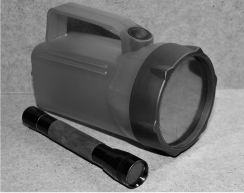
Figure 4-0 This project will explore several ways to convert visible light into infrared light.
Infrared light falls just below red on the light spectrum, making up the wavelengths from about 750 to about 1500 nm. This light cannot be seen by human eyes, but it can easily be seen by most video cameras, making it useful as a covert lighting method in night vision systems. Some video cameras can even see part of the ultraviolet light spectrum from 200 to 400 nm. That will be covered here as well. The goal will be to pass white light through various materials that will attempt to block out all of the visible light and only pass the light that is invisible to the human eyes, yet visible to most security cameras and spy cameras.
A filter that blocks out all light except for the small portion of the spectrum that falls between 800 and 1000 nm is called an infrared pass filter. This effect is exactly the same effect seen by placing a colored lens over your eyes to see the world in a different color tone. If you place a green piece of translucent plastic over your eyes, the world will look green because only the light from the 490 to 560 nm wavelength will reach your eyes. An infrared filter will do exactly the same thing, but since you cannot see infrared light, the filter material will seem completely dark to your eyes. When you place an object made of translucent infrared material in front of a video camera, it will look completely clear, as if the camera had some special ability to see through a solid object.
This infrared pass filter effect can be exploited to create a very powerful infrared illuminator by passing white light through the filter to extract and send out only the infrared light that the video camera can see. The benefit of this approach over the use of infrared leds is that a very small and powerful as well as a very large and extremely bright illuminator can be made. The objects shown in Figure 4-1 all exhibit some infrared passing abilities, which will be explored using a small black-and-white security camera and some white light from an incandescent flashlight bulb.
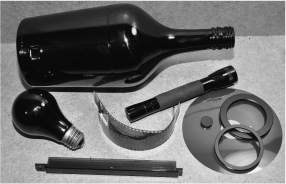
Figure 4-1 Infrared pass filters can be made from many different materials.
To view the invisible (to humans) infrared radiation, an ultra low-light (lux) security camera will be used so that the infrared light can be viewed on a monitor as though the camera was looking at white light (Figure 4-2). These inexpensive camera modules run from 9 to 12 volts (V), and output a standard composite color or black-and-white video signal. There are many suppliers on the Internet. You can expect to pay between $10 and $100, depending on the quality of the camera. Standard camcorders will not work for viewing infrared light, though, as they contain infrared blocking filters in their optics in order to achieve a higher quality visible-light reception. You can try a camcorder, but chances are that it will see only a tiny fraction of the infrared or ultraviolet light spectrum.

Figure 4-2 The test rig will consist of a lowlux video camera and small LCD monitor.
The camera we used is a model KPC-EX20H from the company KT&C in Japan. It’s a very lowlux and high-resolution camera that has worked extremely well in our night vision experiments. This camera is also distributed by SuperCircuits.com under the model name of PC182XS, selling for around $100. decent low-lux monochrome cameras can often be purchased for much less, but this one has a very low-lux rating and high-resolution CCD imager. The liquid crystal display (LCD) monitor is one of those portable gaming screens, and can be connected to any composite video input.
Some of the more obvious materials that can be used to pass only infrared light (radiation) can be found in remote control devices that use infrared LEDs for communication. Older TV remotes often place the LEDs behind a small infrared filter window; the same is true for the receiver in the actual appliance. This plastic will look perfectly black to human eyes, but as you can see in Figure 4-3, the video camera sees right through it as if made of clear plastic!

Figure 4-3 The camera can see right through any translucent infrared materials.
The long plastic bezel that is shown perfectly clear to the camera in Figure 4-3 is the face plate taken from an older infrared wireless headphone set. To our eyes, the part looks perfectly black. We can only see a tiny amount of light through it if we hold it up to our room lighting. But to the camera, it looks like clear plastic, able to pass all of the infrared light to the charge-coupled device (CCD) imager, which is then displayed on the LCD monitor as white light. To a color security camera, the infrared light would look slightly reddish, yet still appear to be lit from a visible light source. Interestingly, the Nikon camera we used to take this photo could see through the plastic just enough to make it look semitranslucent. To our own eyes, though, the plastic is almost completely black.
The bulb shown in Figure 4-4 is called a “black light” bulb and will emit mostly ultraviolet radiation in the 340 to 400 nm range. These bulbs are often used for special-effect lighting, where a certain phosphorescent color is made to look as though it is glowing in the dark. These bulbs are also used for medical purposes, as well as to identify the anticounterfeiting security strip on money. In this project, the ultraviolet light will be used as an illumination source, giving the security camera the ability to see the entire room with light that human eyes cannot perceive.

Figure 4-4 An ultraviolet light bulb also looks like clear glass to the video camera.
As you probably already know, ultraviolet radiation in high doses is not healthy for the skin or eyes, and although a black light is designed for “human safe” operation, it is certainly not a good idea to expose your eyes to the light for extended periods of time. If you are going to purchase a black light bulb, follow the warnings on the package, and remember that just because you can’t see much light coming from the bulb, it doesn’t mean that there isn’t light. In reality, the most dangerous effect of the black light might be the intense heat that is generated by the bulb due to having most of the visible light blocked by the glass. These things get extremely hot in seconds, unlike “standard” white light bulbs.
The black light (shown in the monitor in Figure 4-4) becomes so transparent that you can even see the tungsten filament and connecting wires inside the bulb. To our eyes and the digital camera used to take this photo, the black light bulb looks completely dark. It is strange to see the camera see right through it without any effort at all. This means that the black light bulb will be an amazing source of illumination for the video camera, which is obviously sensitive to the ultraviolet light. The downside is that the bulb also passes some light in the visible violet end of the spectrum, so the area being illuminated will have a dull purple glow that can be seen by human eyes. Of course, there are ways to block the violet light, as well other techniques shown in the next few steps.
Once you have a low-lux black-and-white security camera connected, you can test all kinds of dark-looking materials for their ability to perform as infrared pass filters. Some of the materials that pass infrared light are shown in Figure 4-5—exposed camera film and floppy disk material. Having a massive collection of retro junk on hand, we were able to find some old 5.25-inch (in) floppy discs to hack up, but the smaller 3.5-in types will also give the same results. Oh, and don’t worry, we didn’t hack up the Commodore Dos 3.3 disks—those are classics!

Figure 4-5 Developed film and floppy disk material can be made into infrared pass filters.
Exposed film is also a good material that will block most visible light and pass infrared radiation, but we found that the film would also pass some deep red light as well. The film used is just common 35-mm film that has been exposed and then developed. In other words, you load a new roll of film into your camera, point it at an evenly lit surface, and then snap away until you have as many frames as you need to cut up and make your filter. Even the film from a disposable camera will work fine, and remember to tell film processors that you purposely made blank photos when you bring it in for developing, or they may toss out your negatives.
As for the light source, a standard halogen bulb hand-held flashlight will be used, as these light sources also include a large infrared component. Because the film and the floppy disk material cannot withstand a great deal of heat, the flashlight is a better choice than a larger incandescent light source. A 60-watt (W) white light bulb might offer more illumination, but the thin film would certainly melt within seconds of being exposed to such intense heat. Remember that for a filter to block light, it must also absorb the light, which means a great deal of heat must be contained as well.
To test the material for its ability to work as a night vision illuminator, it is placed in front of a small halogen bulb flashlight and viewed on the monitor. As shown in Figure 4-6, the exposed camera film passes a great deal of infrared light, creating a huge bloom on the camera as it shines onto the CCD sensor. The camera film was so good at passing infrared light that it almost looked the same is if the flashlight was shone directly at the camera. The downside to the camera film is that it also passes some amount of deep red visible light, so it wouldn’t be the optimal solution for a purely covert night vision illuminator. But if we placed four strips of the film together to form a thicker filter, then most of the visible red light was absorbed at the expense of about half of the infrared brightness. This makes the camera film a good candidate for use as an infrared pass filter, as long as several layers are used along with a fairly bright white light source. When dealing with thin film that could be easily melted, care must be taken not to use a light source that will radiate a lot of heat.

Figure 4-6 The camera film allows a lot of infrared light to pass through to the camera.
Since the camera film seemed to be a good choice of material to make a cheap infrared pass filter, we wanted to see if we could find a strong light source that would not melt the film. Ultrabright white LEDs seemed like a logical choice, and they were magnitudes brighter than any of the infrared LEDs we had on hand. Unfortunately, the light given off by a white LED is not the same full spectrum of radiation given off by a halogen flashlight bulb, as we found out. In fact, a white LED is manufactured by placing a special florescent coating over an ultrabright blue LED, which makes the coating give off white light that has very little infrared component. As you can see in Figure 4-7, the ultrabright 3 LED closet light is only slightly visible to the camera after it passes through the infrared pass filter made by the camera film. Results of using white LEDs as a possible light source = total fail.
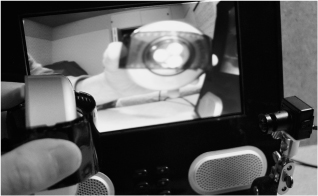
Figure 4-7 White LEDs were tested but failed to produce enough infrared light.
Incandescent flashlights use incandescent lamps like the ones shown in Figure 4-8, which consist of a glass bulb and a tungsten filament. A tungsten filament gives off radiant energy in the visible light spectrum as well as the nonvisible infrared spectrum. The amount of infrared radiation given off by these bulbs is high enough that after blocking out all of the visible light, a decent amount of illumination can be generated for a night vision illuminator. The good news is that the small battery-operated bulbs do not give off enough heat to melt thin plastic filters. The bad news is that the illumination is not strong enough for outdoor use. If your goals are to illuminate a small room for covert surveillance, then the flashlight bulb may be the perfect source for your illuminator. Larger halogen lights such as those used in auto headlights will also offer the same wide spectrum of light, but with much increased heat radiation.

Figure 4-8 The light given off by an incandescent flashlight bulb is high in infrared.
The next material tested was the inner film surface taken from one of the old 5.25-in floppy disks shown in Figure 4-5. As can be seen in Figure 4-9, the disk material passes a good amount of the visible light from the flashlight, but passes almost no visible light that can be seen by human eyes or the camera that took the photo. The floppy disk material was actually far superior as an infrared pass filter than the exposed camera film, as it did not require multiple layers to block out visible light. Of course, it is not easy to dig up a pile of old floppy disks unless you are an intense junk collector, so the exposed camera film may be the better choice. To make the camera film work as well as the floppy disk material, four layers of film had to be stacked to block the same amount of visible light.

Figure 4-9 The disk material passes a good amount of infrared and blocks most visible light.
The first illuminator we made was using the floppy disk material and the high brightness pocket flashlight shown in Figure 4-10. The beam from this flashlight is highly focused, but very bright so the illuminator would have the same characteristics when viewed using the spy camera. Because we do a lot of infrared experimentation, it was nice to have a small and highly focused source of infrared light that could be added to our tool kit. The 5.25-in floppy disc had enough area to allow a 2-in-diameter circle to be cut, which was much more than necessary for the small pocket flashlight. Even the disc from a 2.5-in floppy disc would be plenty of material for a small flashlight lens. The disc was traced for cutting as shown in Figure 4-10.
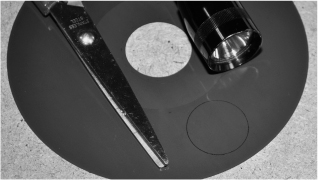
Figure 4-10 Cutting a portion of the floppy disc to fit over the flashlight lens.
The small pocket light worked very well and was able to illuminate an area about as large as the original flashlight would as viewed by the naked eye. The floppy disc material blocked enough of the visible light that you could barely see the dull red glow when looking at the beam from a few feet away. Knowing that the disc material worked so well as an infrared pass filter, we decided to make another portable illuminator, but this time using a much larger and brighter flashlight.
The flashlight shown in Figure 4-11 has a lens diameter of about 4 in, and a much stronger beam powered by a 6-V lantern battery. The heat produced by the small bulb is still low enough that the film would not melt, even during extended use. Because of the increased diameter of the larger lens, we had to cut two half-circles from the floppy disc surface to cover the entire lens, but this wasn’t a problem as long as there was a slight overlap to block any visible light from escaping. The infrared pass filter was placed between the lens and the reflector and held in place by friction.
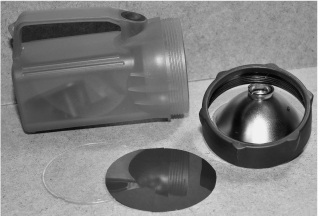
Figure 4-11 Making a larger more powerful illuminator using a flashlight.
Both infrared beam flashlights shown in Figure 4-12 work very well in conjunction with any security camera or low-lux spy camera. The small light is good for close-up work that requires a sharp focused beam, and the larger flashlight can illuminate an entire room for covert security operations. The only drawback to using this type of illumination source for stealthy operations is that there is a very slight noticeable glow visible at close range, so you couldn’t use these illuminators in a head-worn night vision illuminator and expect to remain completely invisible. For use as security camera night vision illuminators, the two flashlights will work very well.

Figure 4-12 The two infrared beam flashlights made using the disc material.
Figure 4-13 shows what the security camera sees when we turn off all of the room lights and point the larger infrared beam flashlight up at the ceiling. The beam is so bright to the camera that the automatic iris ends up closing to block out the overabundance of light. To our eyes and the camera taking the photo, there is only a dull red glow coming from the center of the flashlight lens, but it is not very bright at all. After a few minutes of operation, the lens and infrared pass filter material remain cold.
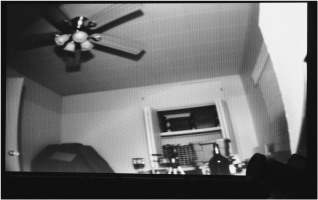
Figure 4-13 The two infrared beam flashlights made using the disc material.
Since we had plenty of film on the roll we had developed, we decided to make a third infrared flashlight using four layers of the exposed camera film as well. The floppy disc material worked a bit better when it came to blocking visible light, but the camera film would probably offer a slightly brighter beam and shift into the nearer infrared spectrum of between 750 and 850 nm. Actually, the exact bandwidth of the infrared light depends on the type of film and how it was developed, so your results will probably vary.
A typical D-Cell battery flashlight was used for this version of the handheld illuminator, and eight slices of film were cut up as shown in Figure 4-14 in order to create the two semicircles that would be needed to cover the lens area on the flashlight. To avoid any visible light leaks, the two half-circles are made to slightly overlap. Also notice that in Figure 4-14 the camera used to take this photo can see through the developed film somewhat, as compared to not being able to see through the floppy disc material at all. This would indicate that the color of the film has some overlap between the end of the infrared spectrum and the start of the visible red spectrum.
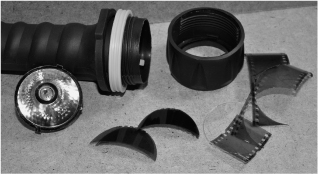
Figure 4-14 Creating a similar infrared beam flashlight using the camera film.
With four layers of camera film covering the flashlight lens shown in Figure 4-15, not much of the visible red light escapes, but the deep red glow is still more noticeable than when using the floppy disc material as an infrared pass filter. The illumination from this version of the handheld infrared illuminator is very bright, but the noticeable deep red glow detracts from any possible stealth night vision use. For infrared photography, this illuminator would be ideal, and as many have discovered, placing the exposed film over the lens on your digital camera gives the same type of infrared filtering as an expensive infrared filter from a camera shop. By using both the infrared illuminator and the infrared pass filter on a digital camera, you can experiment with some very interesting infrared photography.

Figure 4-15 The completed near-infrared beam flashlight using the camera film.
If you have the budget, then you can also purchase high-quality infrared pass filters that are designed to attach to various camera lenses. The two filters shown in Figure 4-16 have threads on the outside, are made from glass, and have very sharp infrared band pass abilities, making them ideal for infrared photography as well as illumination filters. The downside to using these types of filters for illuminations is that they are expensive, and may cost you between $100 and $300, depending on the size and type of material used. The benefit to using a glass filter is that it can withstand a lot more heat, so you can send a much brighter beam into the filter to extract much more infrared radiation. Most camera shops will be able to order infrared filters in various sizes, and some industrial supply centers can even cut custom-sized infrared filters or source them in sheets.

Figure 4-16 These are manufactured infrared pass filters designed to fit camera lenses.
The infrared illuminator shown in Figure 4-17 was made by fitting a glass infrared pass filter over the end of a steel can that contains a 60-W incandescent light source. This infrared illuminator throws out a lot of infrared radiation, but also gets extremely hot in a short time. For this reason, such a system is really only usable outdoors or for short controlled intervals. The efficiency of such a system is also dependant on the infrared capabilities of the original light source, with halogen being a good choice, followed by a full spectrum incandescent bulb. High-efficiency florescent lights are not suitable for infrared illumination as they do not output much infrared radiation.
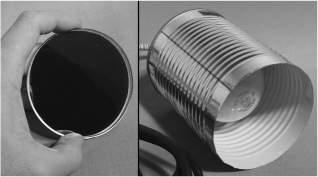
Figure 4-17 A glass infrared filter is installed in front of a 60-W light source.
The completed glass filter illuminator is shown in Figure 4-18, and can plug directly into a standard AC outlet. The illumination from this version is very strong and does block most of the visible light, but this comes at the cost of running extremely hot. This infrared pass filter will also work well with the low-power flashlight bulbs, but is a little too large and thick to fit into the flashlight lens cover. Another decent light source that was tested on this filter was a round halogen motorcycle headlight running from a 12-V DC power source. The resulting heat was slightly less than the incandescent bulb, but required a less portable power supply.

Figure 4-18 This illuminator is quite powerful, but runs extremely hot.
If you don’t mind having a deep purple glow around the room, then the black light shown in Figure 4-19 will make a ready-to-use night vision illumination system right out of the box. Because the CCD imager in most security cameras can see ultraviolet light in the same way it can see infrared light, the black light makes it easy to illuminate a scene with light that human eyes cannot see. The downside to the ultraviolet light is that it also casts a low level of visible violet light and will run as hot as a toaster within seconds of use. Interesting side effects of the ultraviolet illumination include phosphorescence of certain materials and the ability for many digital cameras to pick up the ultraviolet light, which is strong, around 250 nm.
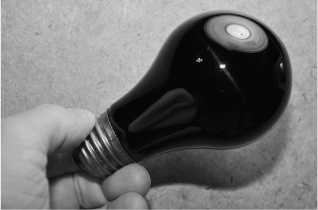
Figure 4-19 This black light is a plug-and-play illumination source for video cameras.
The interesting shot shown in Figure 4-20 was taken by running the 60-W incandescent black light in our desk lamp as we photographed both the light and the scene as viewed on the monitor by the low-lux black-and-white security camera. The digital camera used to take the photo picked up the dull violet glow from the ultraviolet light and was able to see right through the bulb to capture the lit tungsten filament. On the monitor, the camera easily sees the nearby objects in the room as well as the super bright phosphorescence of our black sweater. Another interesting effect of using the ultraviolet illumination is the ability to see right through certain materials, revealing what is underneath somewhat. This effect has been dubbed “X-ray vision,” and the effect can be seen from illumination by both infrared and ultraviolet light sources. The X-ray effect can almost see through certain types of clothing, but the effect really depends on materials, lighting, and infrared heat.
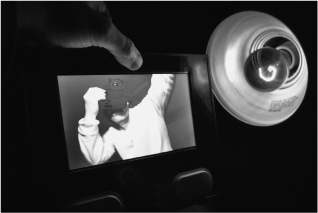
Figure 4-20 An interesting night shot using the 60-W ultraviolet light bulb.
The image shown in Figure 4-21 was captured by feeding the video input on a standard camcorder with the output from our small spy cam while illuminating the scene with the small handheld infrared flashlight shown in Figure 4-12. By looking through the camcorder’s viewfinder, we essentially have a portable night vision viewer that can record everything it sees in pure darkness, allowing me to navigate by looking at the scene in the viewfinder. The handheld flashlight makes it easy to illuminate the part of the room we need to see while we walk around in complete darkness.

Figure 4-21 Using the small infrared flashlight with a portable night vision viewer.
Some of the other materials that we found had some infrared passing abilities were dark glass bottles, camera lens caps, thin black plastics, some black paints, and even some cloth materials. Have fun creating light that only your spy cameras can see. If you find a new material that has great filtering capabilities, stop by the LucidScience.com forum and tell us about it.
